Lenovo Legion 5 (15) review – playing it safe but still delivering
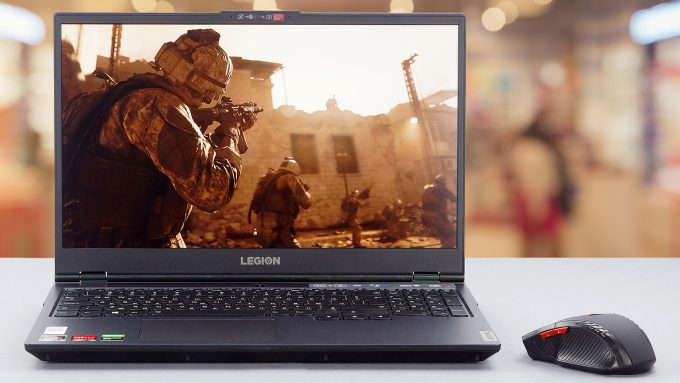 Lenovo’s Legion series is one of the best sellers on the market. And this is no coincidence. They are constantly delivering quality at a relatively low price, making it one of the best gaming notebooks in terms of value. While in previous years, pretty much all of the devices were powered by Intel processors, it is good to see that Lenovo is staying adequately up to date with the current situation of the market.
Lenovo’s Legion series is one of the best sellers on the market. And this is no coincidence. They are constantly delivering quality at a relatively low price, making it one of the best gaming notebooks in terms of value. While in previous years, pretty much all of the devices were powered by Intel processors, it is good to see that Lenovo is staying adequately up to date with the current situation of the market.
Not only does AMD provide better performance than its long-dominating counterpart, but it does so at a lot more competitive price. Apart from that, you get pretty much the same design, Lenovo introduced with the Legion Y530, but it is now improved in a couple of departments. Additionally, your graphics card choice is spreading out from the GeForce GTX 1650, all the way up to the RTX 2060, and everything in between.
As far as the displays go, there are a couple of fast-paced displays (120Hz and 144Hz), and a 60Hz unit, which supposedly covers the entire sRGB color gamut, something Web designers and artists would definitely look after, given the notoriously low-key visuals of the notebook.
You can check the prices and configurations in our Specs System: https://laptopmedia.com/series/lenovo-legion-5-15/
Contents
Specs Sheet
- HDD/SSD
- up to 2000GB SSD + up to 2000GB HDD
- M.2 Slot
- 1(2)x 2280/2242 M.2 PCIe x4 See photo
- RAM
- up to 64GB
- OS
- Windows 10 Home, Windows 10 Pro
- Battery
- 80Wh, 60Wh, 4-cell, 60Wh
- Body material
- Plastic / Polycarbonate
- Dimensions
- 363 x 259.6 x 23.5 ~ 26.1 mm (14.29" x 10.22" x 0.93")
- Weight
- 2.30 kg (5.1 lbs)
- Ports and connectivity
- 1x USB Type-A
- 3.2 Gen 1 (5 Gbps), Sleep and Charge
- 3x USB Type-A
- 3.2 Gen 1 (5 Gbps)
- 1x USB Type-C
- 3.2 Gen 1 (5 Gbps), DisplayPort
- HDMI
- 2.0
- Ethernet LAN
- 10, 100, 1000 Mbit/s
- Wi-Fi
- 802.11ax
- Bluetooth
- 5.0
- Audio jack
- 3.5 mm combo
- Features
- Fingerprint reader
- Web camera
- HD
- Backlit keyboard
- Microphone
- Dual Array Microphone
- Speakers
- 2x 2W, Harman Kardon
- Optical drive
- Security Lock slot
- Kensington Lock
All Lenovo Legion 5 / 5P (15″ AMD, 2020) configurations
What’s in the box?
This device comes in a rather bulky package, which means damage during shipping is highly unlikely. Inside we found a Legion 5, surrounded by foam and neatly tucked inside a black protective cloth. Beneath this assembly, you’ll see the mandatory paper manuals, as well as a 170W power brick.
Design and construction
Similarly to last year, the laptop is entirely built out of plastic – the lid, the base, the bottom plate – everything. It weighs 2.30 kg – the same as its predecessor, but its profile is 2mm thinner – 22mm in the thinnest point and 24mm at its thickest. In terms of the finish on the product, it has a rubberized feel, which is pleasant to the touch and is far less prone to fingerprints.
Its lid can be opened with a single hand, and it goes for the full 180-degree movement we got used to for the past couple of years. However, be careful with the hinges, as there is a little movement we observed. They will certainly not like it if you hold the laptop for the lid and carry it this way. On the bright side, the side and top bezels are thin and good looking in 2020, and the latter has a protrusion, which helps you lift the lid, and houses the camera/shutter assembly.
Next, there is the base, where we can see the new, improved keyboard. It has a decent travel for a gaming laptop and clicky feedback – definitely clickier than its predecessor’s. Additionally, Lenovo has remained true to the Legion series, by including full-sized arrow keys once again, as well as a NumberPad. Another interesting feature is the new quick fan control shortcut. By clicking the Function key and the “Q” key simultaneously, you will toggle between three modes – Quiet, Auto, and Performance.
How about the touchpad? Unlike its predecessor, this one doesn’t feature its own dedicated buttons. Instead, they are embedded under the surface and they have very little resistance, which is good. The surface, itself, is Mylar, which is a material with similar properties to glass but is far more shatter-resistant. Despite the rather good input devices, the quality of the base itself is not great, as the keyboard deck is quite bendy, even with a small amount of force applied.
Looking at the bottom of the notebook, we see a largely unchanged design, except for the order in which Lenovo has placed the mesh and the cutouts. Additionally, there are the speakers in both front corners, while the exhaust is happening from the back and the sides.
Ports
Like we’re used to for quite some time now, the Legion 5 has most of its ports on the back. This includes the charging plug, an HDMI 2.0 connector, two USB Type-A 3.1 (Gen. 1) ports, one USB Type-A 3.1 (Gen. 1) port with DisplayPort 1.2 functionality, and an RJ-45 connector. Additionally, you’ll find one more USB Type-A 3.1 (Gen. 1) port and a headphone jack on the left, while the right is home to the last USB Type-A 3.1 (Gen. 1) port. By the way, the one on the left is Always On.
Disassembly, upgrade options and maintenance
You have 11 Phillips-head screws separating you from the internals of this notebook. After you undo them, pry the bottom panel with a plastic tool, starting from the front. Be patient, as the embulked part on the back can be a little more difficult to remove.
Cooling-wise we see two big metal plates, covering the VRMs and the memory modules of the graphics cards. Additionally, there are three heat pipes – one shared between the CPU and the GPU and one more for each of them. Thankfully, there are four heat spreaders, which increases the thermal capacity of the entire solution.
As far as the upgradability goes, there are two RAM SODIMM slots. According to Lenovo, they sell the notebook with a maximum of 16GB of DDR4, working at 3200 MHz in dual-channel mode. However, we are pretty positive that it can hold up to at least 32GB in total. In terms of storage, there are two M.2 PCIe x4 drive slots (one of which is blocked by the 2.5-inch SATA drive and we are not really sure it works.
How about the battery? Well, Lenovo sells the Legion 5 with two options – a 60Wh and an 80Wh one, as our particular unit features the smaller of the two.
Display quality
Lenovo Legion 5 (15) in the configuration we tested has a Full HD 120Hz IPS panel with a model number AUO B156HAN13.1 (AUOD1ED). Its diagonal is 15.6″ (39.62 cm), and the resolution 1920 х 1080 pixels. The screen ratio is 16:9, and we are looking at a pixel density of – 142 ppi, and a pitch of 0.18 х 0.18 mm. The screen turns into Retina when viewed at distance equal to or greater than 60cm (24″) (from this distance one’s eye stops differentiating the separate pixels, and it is normal for looking at a laptop).
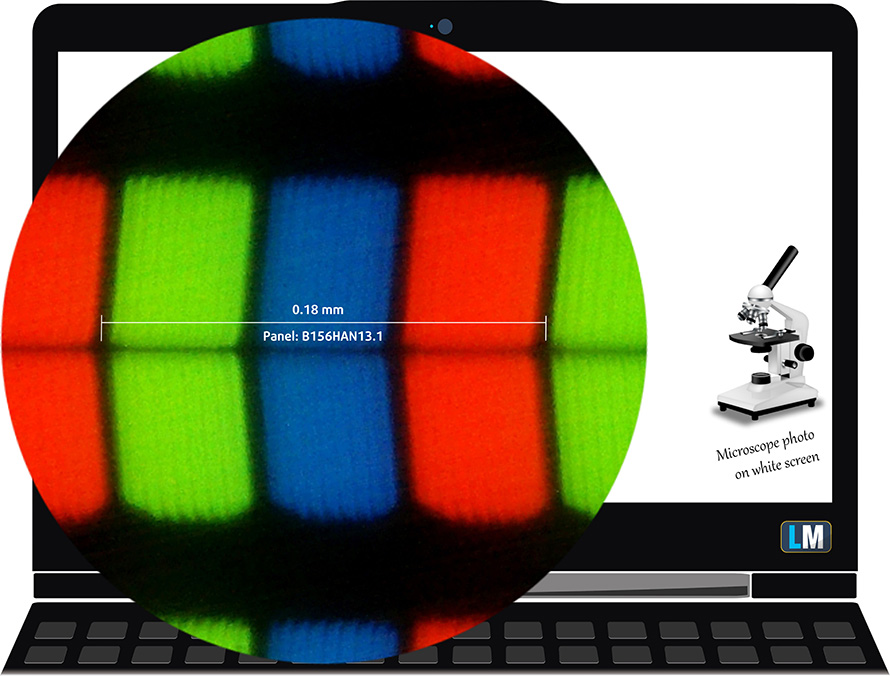
Viewing angles are excellent. We offer images at 45° to evaluate image quality.

We measured a maximum brightness of 307 nits in the middle of the screen and 282 nits as an average for the whole area, with a maximum deviation of 12%. The Correlated Color Temperature on a white screen is 7300K – colder than the optimal for the sRGB standard of 6500K.
In the illustration below you can see how the display performs from a uniformity perspective. In other words, the leakage of light from the light source.
Values of dE2000 over 4.0 should not occur, and this parameter is one of the first you should check if you intend to use the laptop for color-sensitive work. The contrast ratio is good – 1300:1.
To make sure we are on the same page, we would like to give you a little introduction to the sRGB color gamut and the Adobe RGB. To start, there’s the CIE 1976 Uniform Chromaticity Diagram that represents the visible specter of colors by the human eye, giving you a better perception of the color gamut coverage and the color accuracy.
Inside the black triangle, you will see the standard color gamut (sRGB) that is being used by millions of people in HDTV and on the web. As for the Adobe RGB, this is used in professional cameras, monitors, etc for printing. Basically, colors inside the black triangle are used by everyone and this is the essential part of the color quality and color accuracy of a mainstream notebook.
Still, we’ve included other color spaces like the famous DCI-P3 standard used by movie studios, as well as the digital UHD Rec.2020 standard. Rec.2020, however, is still a thing of the future and it’s difficult for today’s displays to cover that well. We’ve also included the so-called Michael Pointer gamut, or Pointer’s gamut, which represents the colors that naturally occur around us every day.
The yellow dotted line shows Lenovo Legion 5 (15)’s color gamut coverage.
Its display covers only 51% of the sRGB/ITU-R BT.709 (web/HDTV standard) in CIE1976.
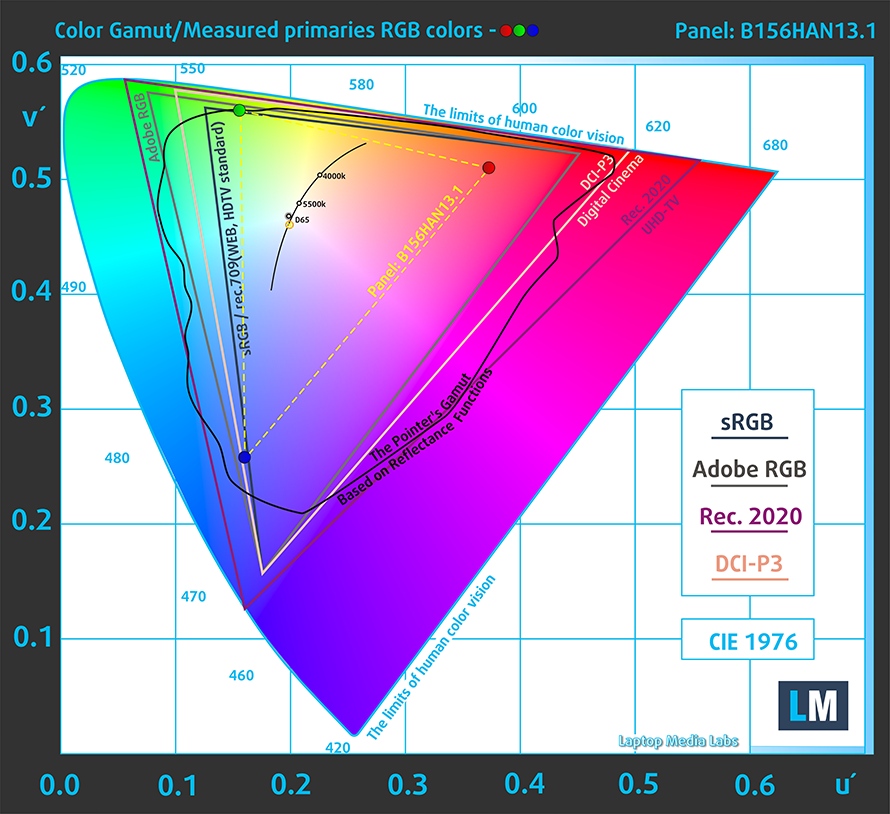
Our “Design and Gaming” profile delivers optimal color temperature (6500K) at 140 cd/m2 luminance and sRGB gamma mode.
We tested the accuracy of the display with 24 commonly used colors like light and dark human skin, blue sky, green grass, orange, etc. You can check out the results at factory condition and also, with the “Design and Gaming” profile.
Below you can compare the scores of Lenovo Legion 5 (15) with the default settings (left), and with the “Gaming and Web design” profile (right).
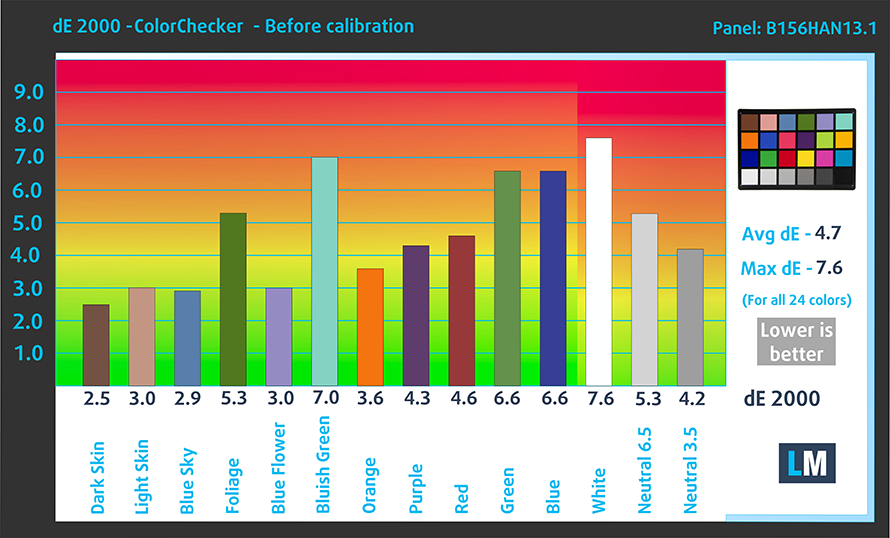

The next figure shows how well the display is able to reproduce really dark parts of an image, which is essential when watching movies or playing games in low ambient light.
The left side of the image represents the display with stock settings, while the right one is with the “Gaming and Web Design” profile activated. On the horizontal axis, you will find the grayscale and on the vertical axis – the luminance of the display. On the two graphs below you can easily check for yourself how your display handles the darkest nuances but keep in mind that this also depends on the settings of your current display, the calibration, the viewing angle, and the surrounding light conditions.
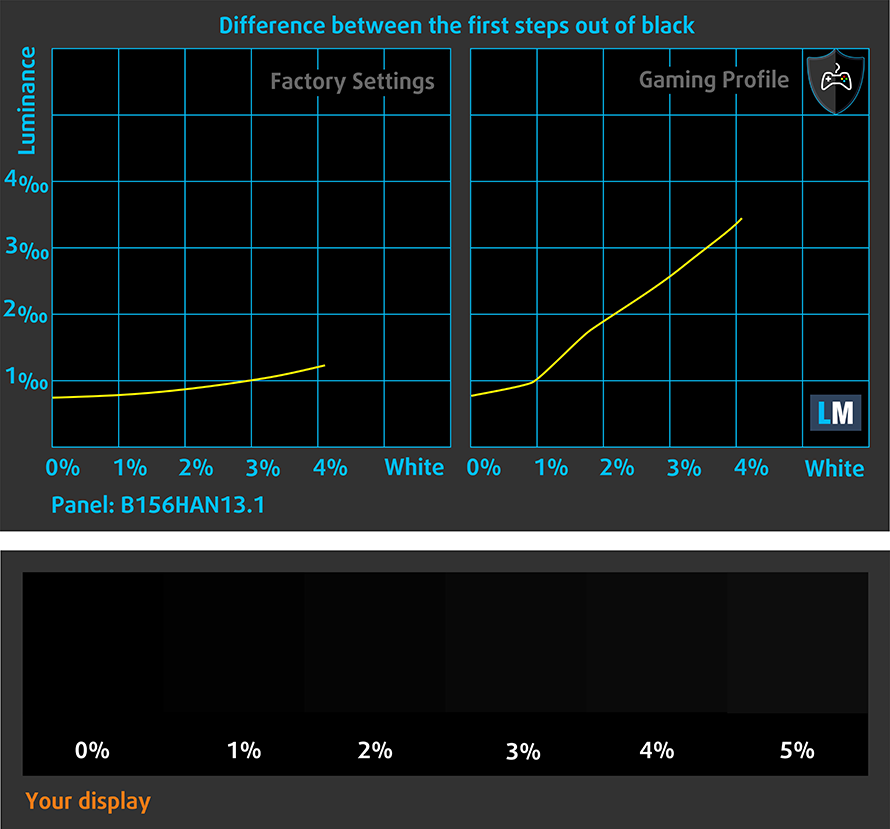
Response time (Gaming capabilities)
We test the reaction time of the pixels with the usual “black-to-white” and “white-to-black” method from 10% to 90% and vice versa.
We recorded Fall Time + Rise Time = 24 ms.
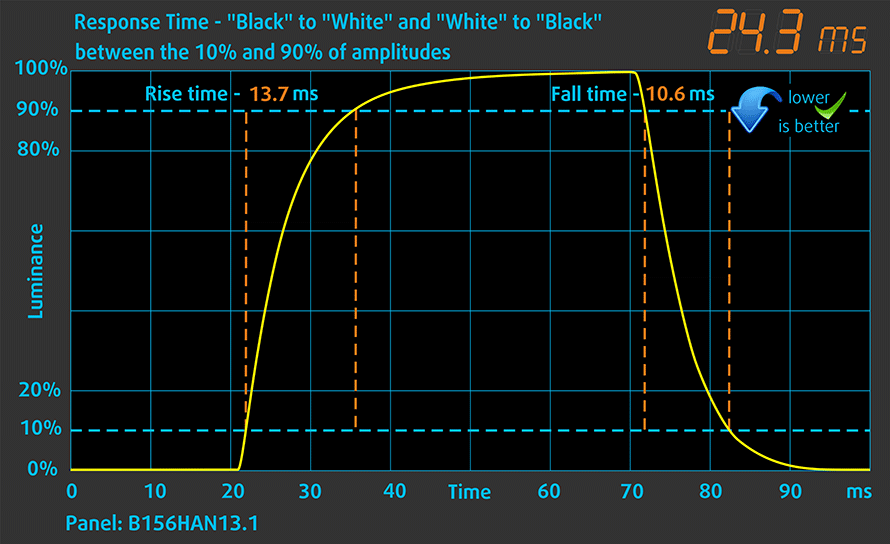
PWM (Screen flickering)
Pulse-width modulation (PWM) is an easy way to control monitor brightness. When you lower the brightness, the light intensity of the backlight is not lowered, but instead turned off and on by the electronics with a frequency indistinguishable to the human eye. In these light impulses, the light/no-light time ratio varies, while brightness remains unchanged, which is harmful to your eyes. You can read more about that in our dedicated article on PWM.
Lenovo Legion 5 (15)’s display doesn’t flicker at any brightness level. This provides comfort in extended periods of use.

Blue light emissions
Installing our Health-Guard profile not only eliminates PWM but also reduces the harmful Blue Light emissions while keeping the colors of the screen perceptually accurate. If you’re not familiar with the Blue light, the TL;DR version is – emissions that negatively affect your eyes, skin, and your whole body. You can find more information about that in our dedicated article on Blue Light.
Conclusion
Lenovo Legion 5 (15)’s display has an IPS panel with a Full HD resolution, comfortable viewing angles and good contrast ratio. Additionally, you can enjoy a non-flickering backlight, but sadly, the 120Hz refresh rate is not paired with fast pixel response times. Moreover, it covers only 51% of sRGB.
Buy our profiles
Since our profiles are tailored for each individual display model, this article and its respective profile package are meant for Lenovo Legion 5 (15) configurations with 15.6″ FHD IPS AUO B156HAN13.1 (AUOD1ED).
*Should you have problems with downloading the purchased file, try using a different browser to open the link you’ll receive via e-mail. If the download target is a .php file instead of an archive, change the file extension to .zip or contact us at [email protected].
Read more about the profiles HERE.
In addition to receiving efficient and health-friendly profiles, by buying LaptopMedia's products you also support the development of our labs, where we test devices in order to produce the most objective reviews possible.

Office Work
Office Work should be used mostly by users who spend most of the time looking at pieces of text, tables or just surfing. This profile aims to deliver better distinctness and clarity by keeping a flat gamma curve (2.20), native color temperature and perceptually accurate colors.

Design and Gaming
This profile is aimed at designers who work with colors professionally, and for games and movies as well. Design and Gaming takes display panels to their limits, making them as accurate as possible in the sRGB IEC61966-2-1 standard for Web and HDTV, at white point D65.

Health-Guard
Health-Guard eliminates the harmful Pulse-Width Modulation (PWM) and reduces the negative Blue Light which affects our eyes and body. Since it’s custom tailored for every panel, it manages to keep the colors perceptually accurate. Health-Guard simulates paper so the pressure on the eyes is greatly reduced.
Get all 3 profiles with 33% discount
Sound
Lenovo Legion 5 (15)’s speakers are tuned by Harman and they sound very good.
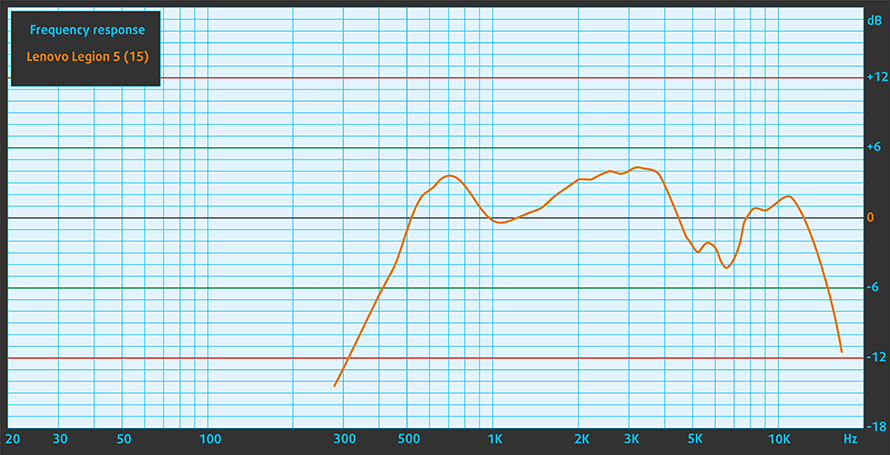
Drivers
All of the drivers and utilities for this notebook can be found here: https://pcsupport.lenovo.com/us/en/products/laptops-and-netbooks/legion-series/legion-5-15arh05/downloads/driver-list
Battery
Now, we conduct the battery tests with Windows Better performance setting turned on, screen brightness adjusted to 120 nits, and all other programs turned off except for the one we are testing the notebook with. We got five hours and 40 minutes of Web browsing and five hours and a half of video playback from the 60Wh battery.
In order to simulate real-life conditions, we used our own script for automatic web browsing through over 70 websites.



For every test like this, we use the same video in HD.



CPU options
Expectedly, there are two main routes you can take. One of them is dressed in Red, while the other is Blue. Should you pick the first option, you have a second choice to make – the six-core Ryzen 5 4600H or the eight-core Ryzen 7 4800H. However, if you opt for team Blue, then you can choose from three different CPUs – the quad-core Core i5-10300H, the six-core Core i7-10750H, and the eight-core Core i7-10875H.
Results are from the Cinebench 20 CPU test (the higher the score, the better)
Results are from our Photoshop benchmark test (the lower the score, the better)
Lenovo Legion 5 / 5P (15″ AMD, 2020) CPU variants
Here you can see an approximate comparison between the CPUs that can be found in the Lenovo Legion 5 / 5P (15″ AMD, 2020) models on the market. This way you can decide for yourself which Lenovo Legion 5 / 5P (15″ AMD, 2020) model is the best bang for your buck.
Note: The chart shows the cheapest different CPU configurations so you should check what the other specifications of these laptops are by clicking on the laptop’s name / CPU.
Results are from the Cinebench R23 CPU test (the higher the score, the better)
Results are from our Photoshop benchmark test (the lower the score, the better)
GPU options
The most common choices here would be the GeForce GTX 1650 and the GTX 1650 Ti, both equipped with 4GB of GDDR6 memory. However, some models may come with the more powerful GTX 1660 Ti (6GB of GDDR6 VRAM), while others will feature the ray-tracing-enabled RTX 2060 (6GB of GDDR6 VRAM).
Results are from the 3DMark: Time Spy (Graphics) benchmark (higher the score, the better)
Results are from the 3DMark: Fire Strike (Graphics) benchmark (higher the score, the better)
Results are from the Unigine Superposition benchmark (higher the score, the better)
Lenovo Legion 5 / 5P (15″ AMD, 2020) GPU variants
Here you can see an approximate comparison between the GPUs that can be found in the Lenovo Legion 5 / 5P (15″ AMD, 2020) models on the market. This way you can decide for yourself which Lenovo Legion 5 / 5P (15″ AMD, 2020) model is the best bang for your buck.
Note: The chart shows the cheapest different GPU configurations so you should check what the other specifications of these laptops are by clicking on the laptop’s name / GPU.
Results are from the 3DMark: Time Spy (Graphics) benchmark (higher the score, the better)
Results are from the 3DMark: Fire Strike (Graphics) benchmark (higher the score, the better)
Results are from the Unigine Superposition benchmark (higher the score, the better)
Gaming tests
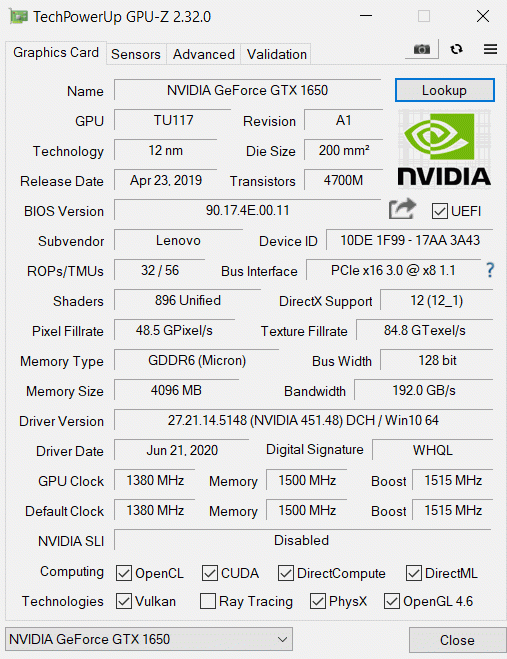

| Far Cry 5 | Full HD, Normal (Check settings) | Full HD, High (Check settings) | Full HD, Ultra (Check settings) |
|---|---|---|---|
| NVIDIA GeForce GTX 1650 | 64 fps | 59 fps | 55 fps |

| Rise of the Tomb Raider (2016) | Full HD, Lowest (Check settings) | Full HD, Medium (Check settings) | Full HD, Very High (Check settings) |
|---|---|---|---|
| NVIDIA GeForce GTX 1650 | 105 fps | 81 fps | 41 fps |

| Shadow of the Tomb Raider (2018) | Full HD, Lowest (Check settings) | Full HD, Medium (Check settings) | Full HD, High (Check settings) |
|---|---|---|---|
| NVIDIA GeForce GTX 1650 | 85 fps | 57 fps | 51 fps |

| Tom Clancy’s Ghost Recon Wildlands | Full HD, Medium (Check settings) | Full HD, High (Check settings) | Full HD, Very High (Check settings) |
|---|---|---|---|
| NVIDIA GeForce GTX 1650 | 55 fps | 51 fps | 45 fps |
Temperatures and comfort
Max CPU load
In this test we use 100% on the CPU cores, monitoring their frequencies and chip temperature. The first column shows a computer’s reaction to a short load (2-10 seconds), the second column simulates a serious task (between 15 and 30 seconds), and the third column is a good indicator of how good the laptop is for long loads such as video rendering.
Average core frequency (base frequency + X); CPU temp.
| AMD Ryzen 5 4500H (45W TDP) | 0:02 – 0:10 sec | 0:15 – 0:30 sec | 10:00 – 15:00 min |
|---|---|---|---|
| Lenovo Legion 5 (15) | 3.71 GHz (B+24%) @ 86°C | 3.55 GHz (B+18%) @ 85°C | 3.44 GHz (B+15%) @ 80°C |
Well, the Legion 5 (15) is maintaining pretty high clock speeds with the Ryzen 5 4600H. And the 80C at the end of the test is a pretty respectable result given the core count.
Real-life gaming
| NVIDIA GeForce GTX 1650 | GPU frequency/ Core temp (after 2 min) | GPU frequency/ Core temp (after 30 min) |
|---|---|---|
| Lenovo Legion 5 (15) | 1659 MHz @ 58°C | 1671 MHz @ 56°C |
| Acer Nitro 5 (AN517-52) | 1746 MHz @ 65°C | 1723 MHz @ 71°C |
| Dell Inspiron 15 7590 | 1395 MHz @ 80°C | 1395 MHz @ 84°C |
| Acer Aspire 7 (A715-74G) | 1552 MHz @ 70°C | 1532 MHz @ 76°C |
| Dell G3 15 3590 | 1605 MHz @ 67°C | 1566 MHz @ 74°C |
| ASUS ROG G531 | 1461 MHz @ 65°C | 1408 MHz @ 71°C |
| ASUS TUF FX705 | 1566 MHz @ 74°C | 1568 MHz @ 74°C |
| Acer Nitro 7 (AN715-51) | 1633 MHz @ 61°C | 1599 MHz @ 67°C |
Now that’s something we like to see. Only 56C on the GPU after 30 minutes of gameplay. This is unprecedented in the laptop world.
Comfort during full load
Although the laptop is not the quietest out there, it is definitely not the loudest too. Additionally, the outer temperature remains quite cool for a gaming notebook.


Verdict
What a great allrounder. This notebook is comfortably good in pretty much everything you do with it. However, as a typical Legion descendant, there are a couple of things that might send some people away. Some of this includes a lack of Thunderbolt 3 connectivity, no SD card reader on board, and poor battery life.
Well, poor is not exactly the right word here, given the fact it’s dealing with a 120Hz display. We were able to get 5 hours and 40 minutes of Web browsing and around 10 minutes less when watching videos.
Lenovo Legion 5 (15)’s display has an IPS panel (AUO B156HAN13.1) with a Full HD resolution, comfortable viewing angles, and good contrast ratio. Additionally, you can enjoy a non-flickering backlight, but sadly, the 120Hz refresh rate is not paired with fast pixel response times. Moreover, it covers only 51% of sRGB.
When it comes to performance, this device doesn’t mess around. Both the CPU and the GPU are on point when it comes to raw power, but when it comes to gaming, you should expect a couple of fps difference, when compared to an Intel CPU with the same graphics card. We’re not sure whether it’s the device in particular, or the Ryzen 5 4600H, but we consistently got around 3 fps difference between this notebook, and the Acer Nitro 5 (AN517-52), which is equipped with the same GPU.
What would be the bottom line, then? Quite honestly, we don’t think 3 fps is a noteworthy difference, but there are the maximalists out there, that won’t forgive the Legion 5 (15) for not being perfect. However, it can handle PCIe x4 drives, up to 32GB (our guess) of DDR4 memory, working at 3200 MHz in dual channel, and a great pair of input devices. The keyboard, in particular, is great for gaming and for typing, and it comes with two backlight options – a non-obnoxious white one, and a four-zone RGB one.
In our view, the Legion 5 (15) is worthy of being your gaming companion. However, stay away from the 120Hz display option, because of its rather washed out image and slow pixel response time – either get the 144Hz model or the 60Hz one, if you are going to use it primarily for content creation.
Pros
- It has two RAM SODIMM slots and two M.2 drives, besides the 2.5″ SATA drive bay
- Great input devices with an optional RGB backlight
- Lacks PWM for brightness adjustment (AUO B156HAN13.1)
- Comfortable viewing angles and good contrast ratio (AUO B156HAN13.1)
- Great performance from AMD’s finest CPUs out there
- A total of five USB 3.1 (Gen. 1) ports (some PCs have less)
Cons
- Lacks an SD card reader
- Slow response times, despite the 120Hz refresh rate (AUO B156HAN13.1)
- Covers only 51% of sRGB (AUO B156HAN13.1)
You can check the prices and configurations in our Specs System: https://laptopmedia.com/series/lenovo-legion-5-15/
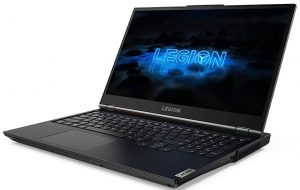
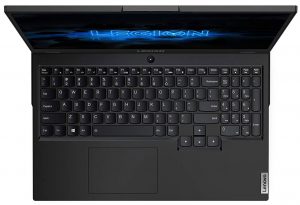
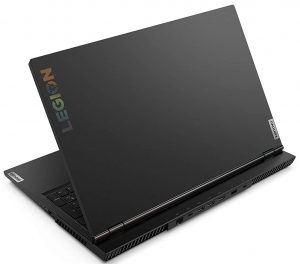

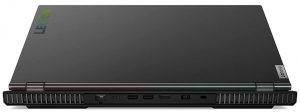

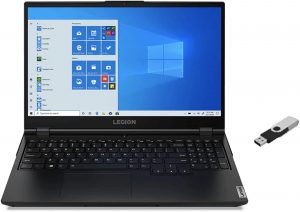
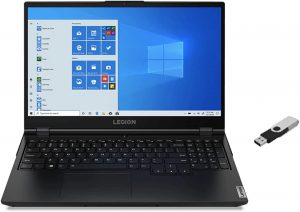

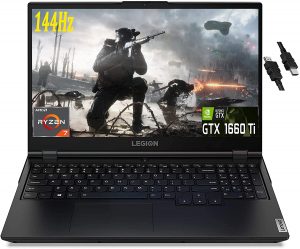
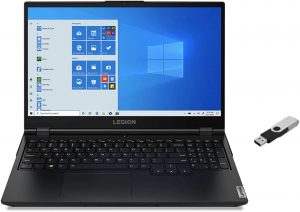
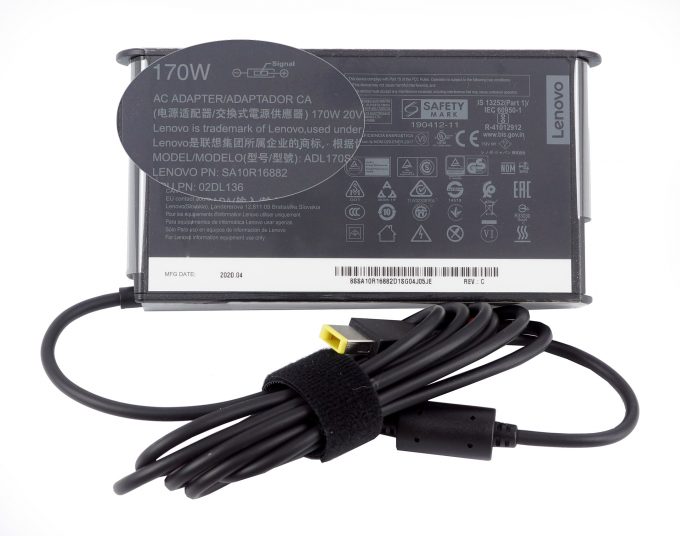
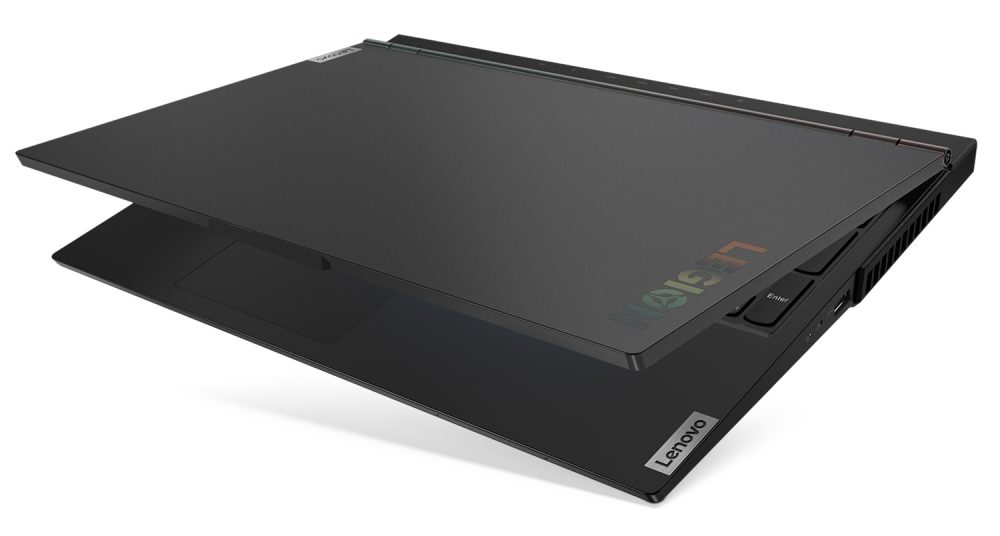
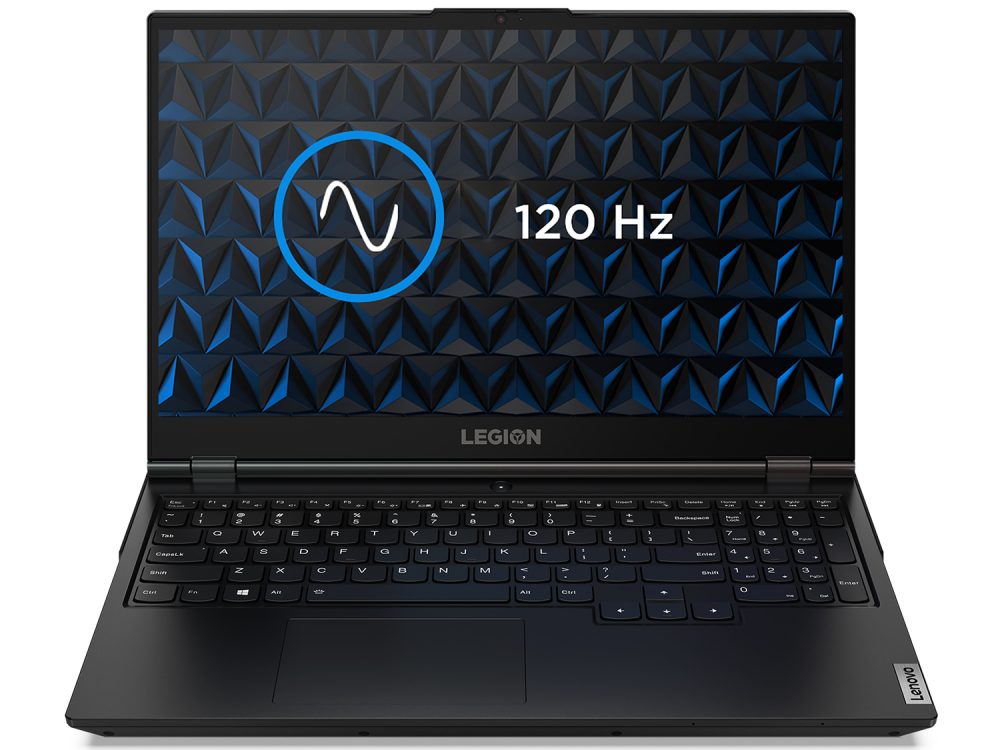
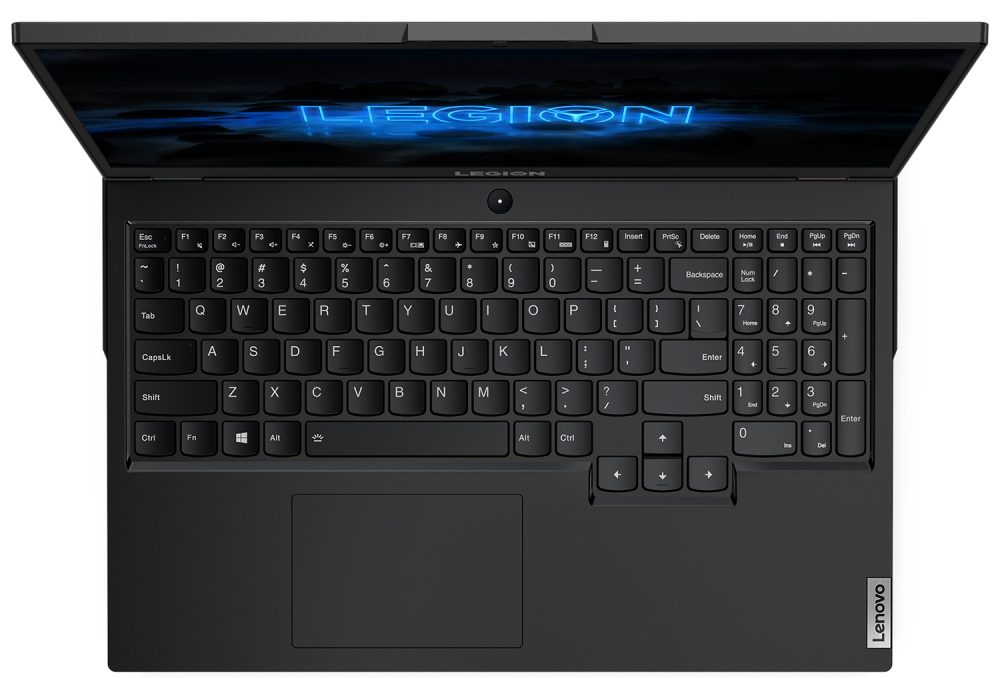
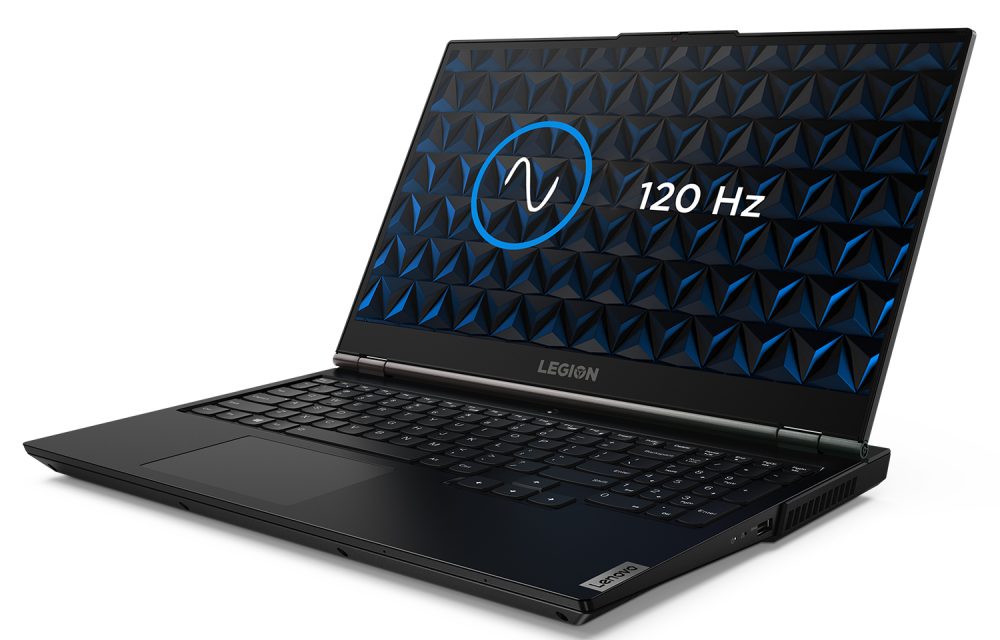
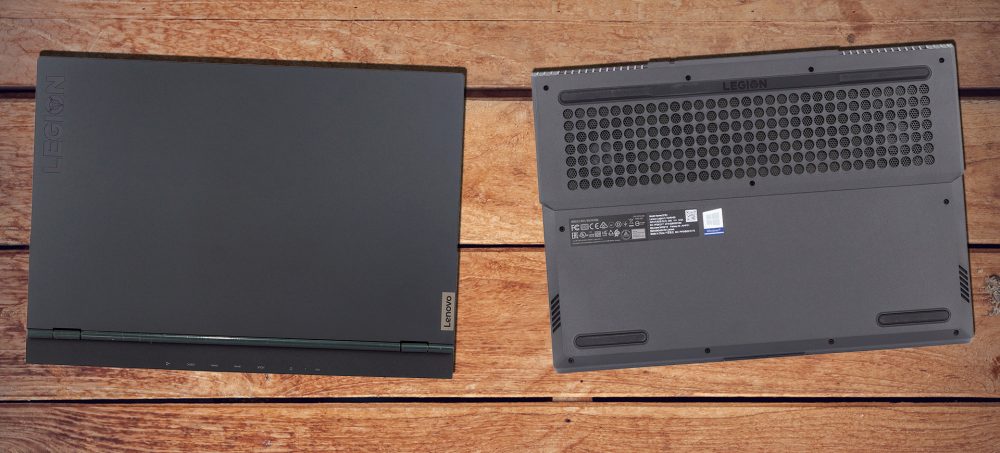

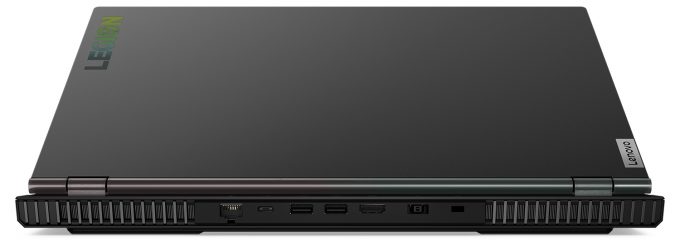

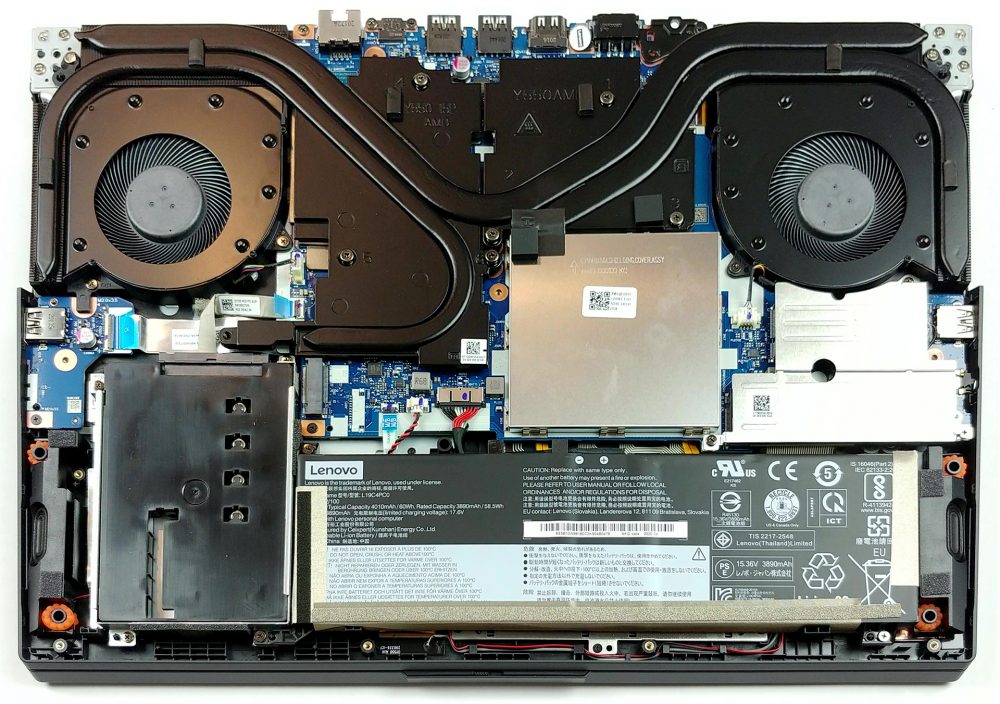
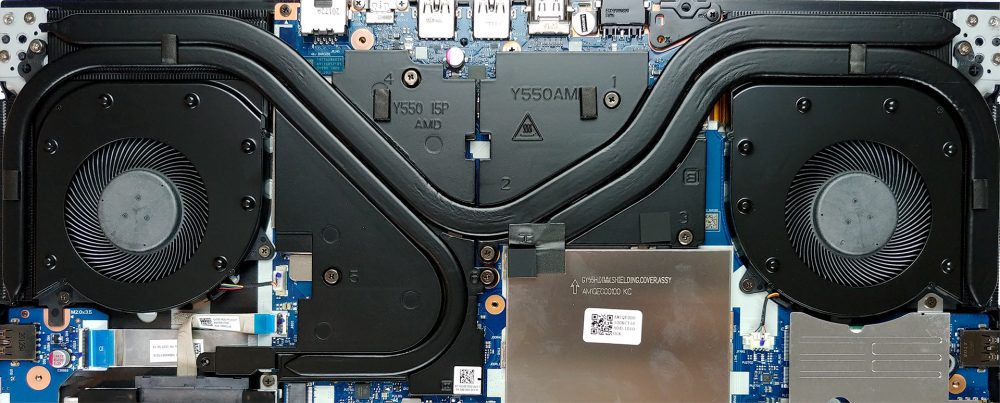
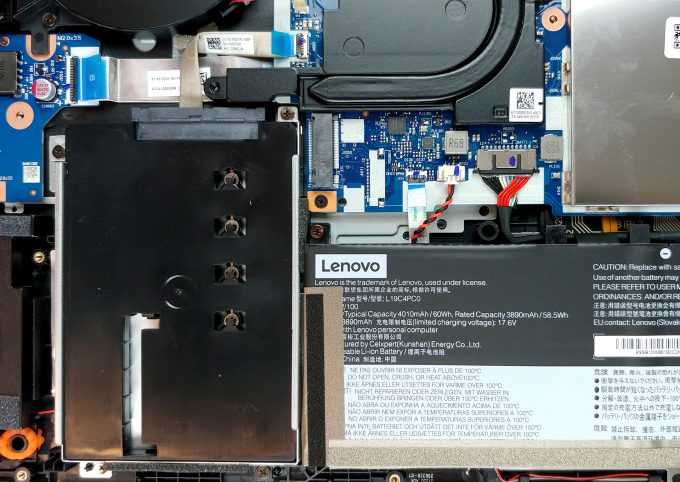

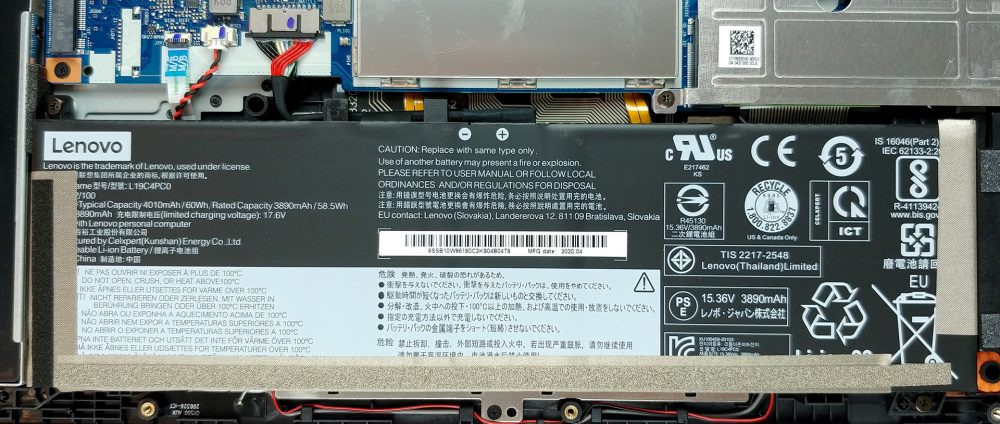
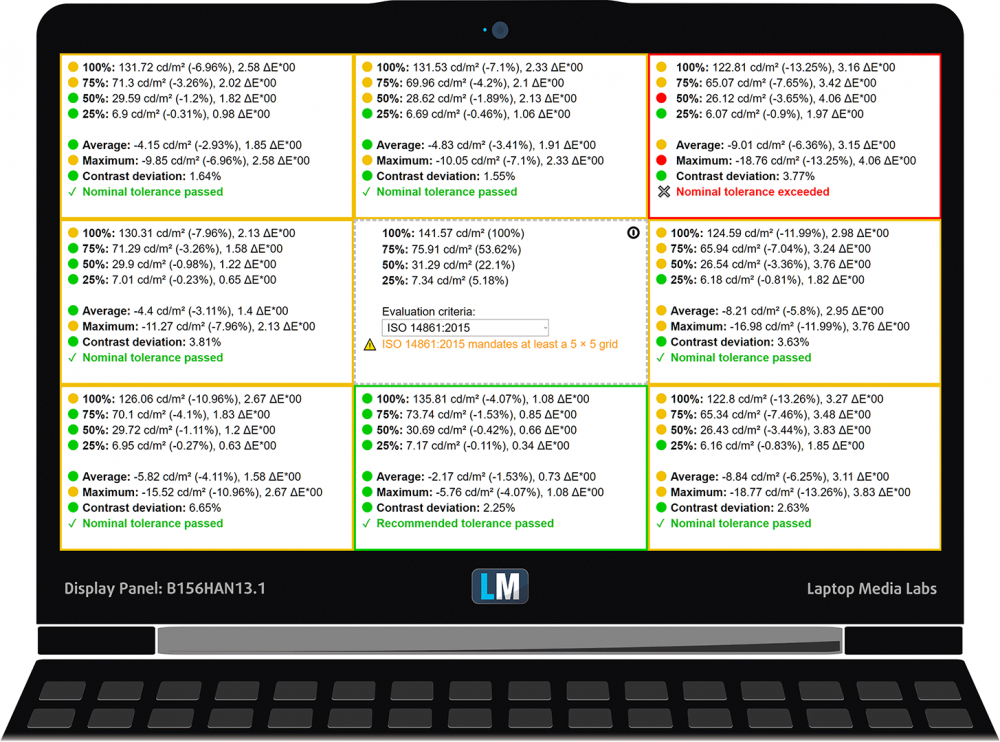

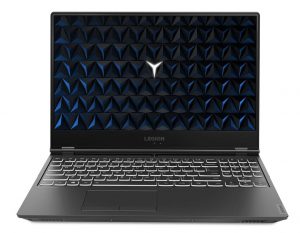
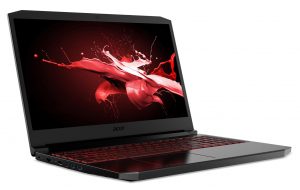








so is there a laptop with 17 inch screen more than 51 percent sRGB and 4800H amd processor
I mean there is legion 5i or 7 as an option…
from Lenovo
15.6″ FHD (1920 x 1080) IPS, anti-glare, 250 nits, 120Hz, 45% CG
15.6″ FHD (1920 x 1080) IPS, anti-glare, 300 nits, 60Hz, 100% sRGB
15.6″ FHD (1920 x 1080) IPS, anti-glare, 300 nits, 144Hz, 5ms response time, 100% sRGB
I don’t know why for a review Lenovo use a so bad screen when a full srgb is available ….. !!
Because it is not expensive and people really need to know how it compares. the other ones have already been reviewed.
I bought this laptop before seeing this review and choose 120hz panel thinking “how bad can it be?” and it is not bad. I can say that if I saw this review before I bought the laptop I wouldn’t struggle that much and get the 120hz anyway.
But that is me that likes cheap options 😉
Can you test if 2° nvme slot is working ?
Please test some RAM and let us know how it is with compatibility. I really don’t like the timings of the stock RAM and wanted to update for some CRUCIAL/g skill SODIMM with tighter timings. Also the maximum amount of RAM would be great to know. Is there also a way to unlock some more BIOS configurations?
Really thankful for the Review. Got the base spec with 120hz display and already bought your color profiles. That is great.
i bought this laptop and very impressed with the cooling system.
you can see in my video here https://www.youtube.com/watch?v=MAZfN3MyrFQ
Did you bought with the same screen? How was your measure of color gamma? does it have dolby vision?
Great review! Just one question about the 120hz display. It is mentioned that uses AUO B156HAN13.1 and your review mention a contrast of 1300:1. But looking for the part number on internet, the contrast is documented at 800:1. The contrast you give in the review was measured or taken from the manufacturer specs? If taken from specs, any hint on where can I find the info?
Many thanks and congrats on the site, it always offers the best reviews!